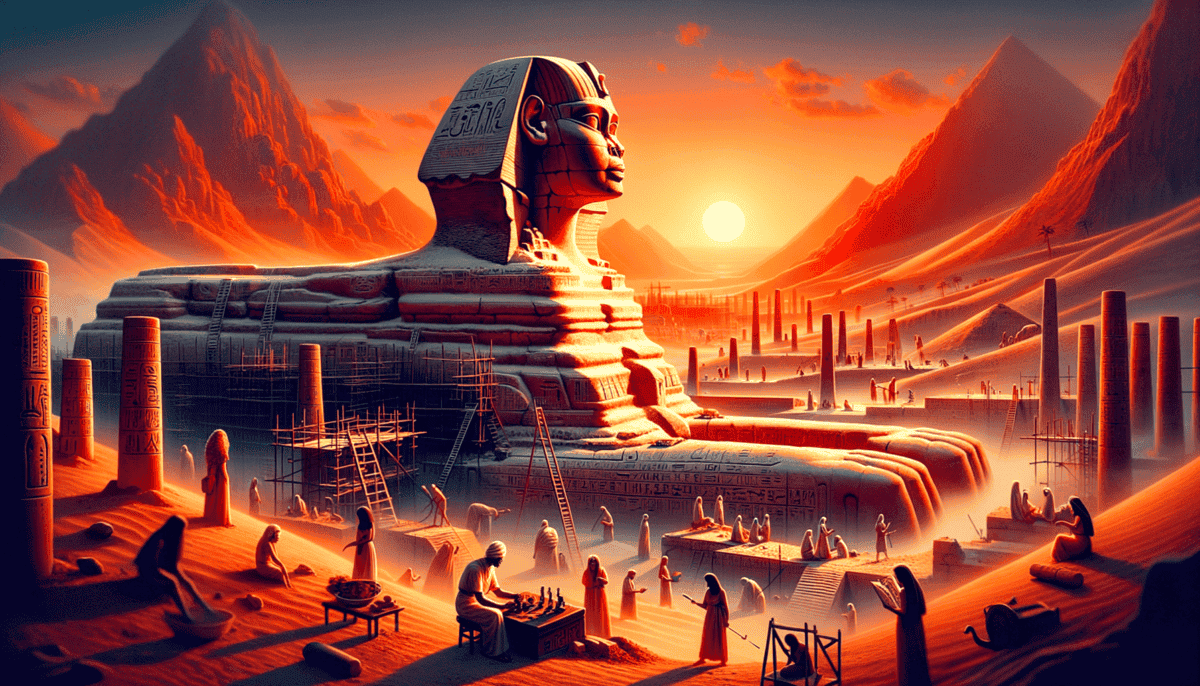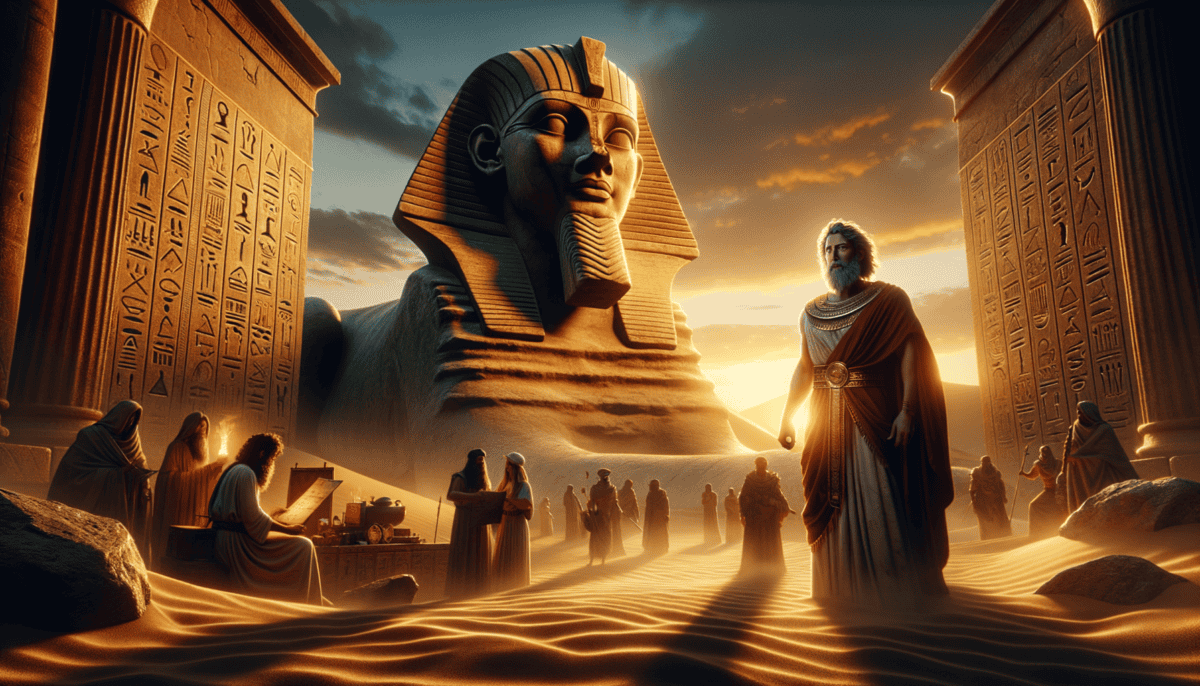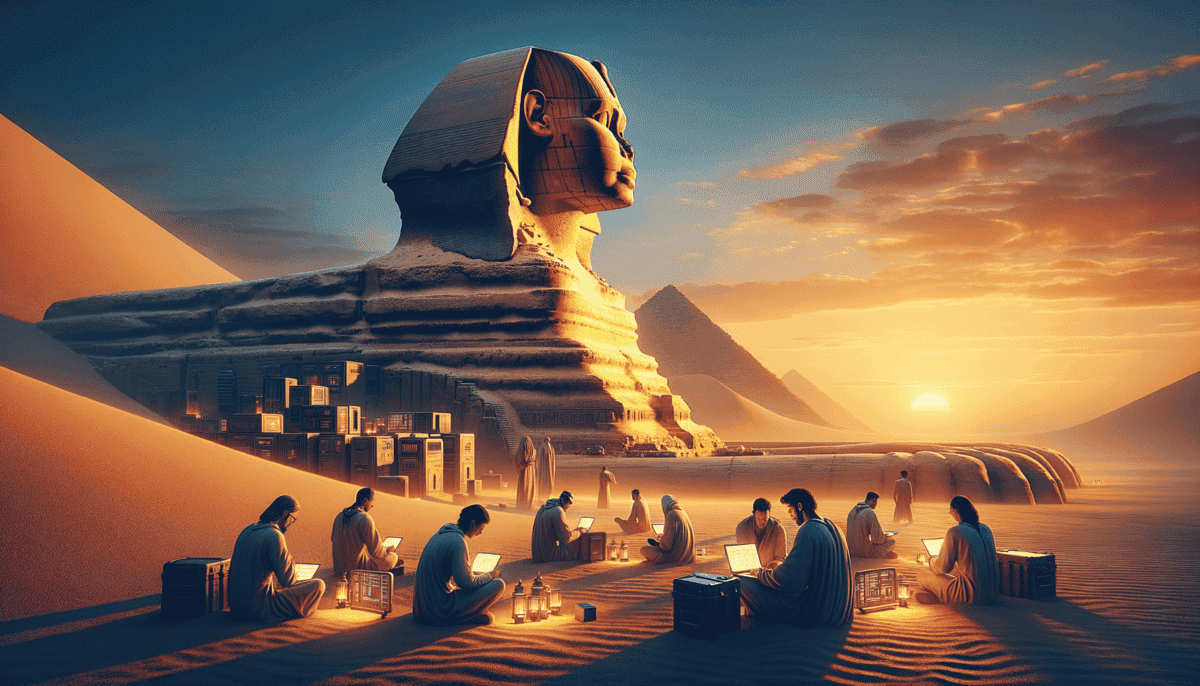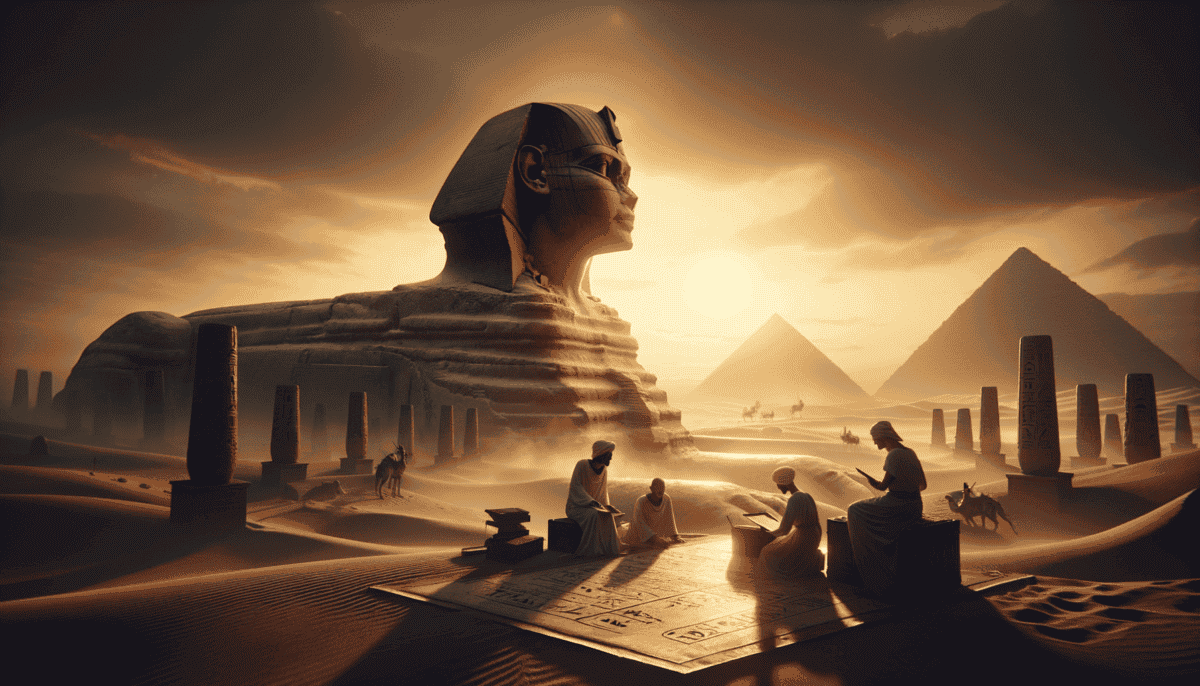The Stone Guardian
In the hot sands of Egypt, a giant statue sits watching over the land. This is the Great Sphinx of Giza! It has the head of a person and the body of a lion. The Sphinx is as tall as a six-story building and as long as two school buses!
"Daddy, why does it look like that?" little Maya asked, looking up at the massive stone figure.
Her father smiled and pointed to the Sphinx's face. "Long ago, the ancient Egyptians built this amazing statue. They believed it had magical powers to protect their land."
The Sphinx's nose is missing, and its face shows signs of age, but it still looks mighty and strong. Sand swirls around its paws, dancing in the warm desert wind. The stone guardian has been here for thousands and thousands of years!
People from all over the world come to see this amazing statue. They take pictures and wonder about its secrets. Many stories say the Sphinx was a riddle master who would ask travelers tricky questions.
"But how did they build something so big?" Maya wondered aloud.
Her father scratched his head. "That's one of the biggest mysteries! The ancient Egyptians were very clever builders. They used huge blocks of limestone rock to make the Sphinx."
The sun began to set behind the Sphinx, making its shadow stretch across the sand. In the golden light, it almost seemed to come alive. Its eyes seemed to hold secrets from long, long ago.
“Some people think there might be secret rooms under the Sphinx,” Maya’s father whispered. “Maybe even a hidden library full of ancient scrolls!”
Maya's eyes grew wide with excitement. She looked at the giant statue differently now. What mysteries could it be hiding? What stories could it tell if it could speak?
The desert wind picked up, making the sand dance around the Sphinx's paws once again. As the stars began to appear in the darkening sky, Maya thought she saw the stone guardian wink at her. Or maybe it was just her imagination…
Scientists still study the Sphinx today. They use special tools to look inside and around it. Every year, they find new clues about how it was built. But many questions remain unanswered:
- Who exactly built the Sphinx?
- Why did they make it so big?
- What secrets does it still hide?
- Are there really hidden rooms underneath?
As night fell over the desert, Maya and her father walked back to their hotel. The Sphinx stood silently in the moonlight, just as it had for thousands of years. It would keep watching over Egypt, holding its secrets close, waiting for someone clever enough to solve its ancient mysteries.
"Can we come back tomorrow?" Maya asked sleepily.
"Of course," her father answered. "The Sphinx isn't going anywhere. It's been standing guard here since before the pyramids were finished!"
The stone guardian continued its endless watch, its eyes fixed on the horizon, while the desert winds whispered tales of pharaohs and ancient magic around its weathered paws.
Secrets of Sand and Stone
The morning sun lit up the desert, showing thousands of workers busy at the Sphinx site. Maya and her father had come early to watch the archeologists at work.
“Look, Maya!” her father pointed. “They’re showing how the ancient Egyptians built the Sphinx.”
Dr. Sarah, a friendly archeologist with curly hair, waved them over. “Want to learn how they made this giant statue?” she asked with a smile.
“First, they found a big hill of limestone rock,” Dr. Sarah explained. “Then, they used copper chisels and wooden hammers to shape it.”
Maya’s eyes got big. “That must have taken forever!”
“It sure did! Hundreds of workers spent years carving the Sphinx. They worked in teams:”
- Stone cutters who shaped the rock
- Artists who carved the details
- Workers who carried away the extra stone
- Painters who added bright colors
“Colors?” Maya asked. “But it’s all one color now!”
“The Sphinx used to be painted in bright reds, blues, and yellows! The desert sun and wind wore the colors away over time.”
Dr. Sarah showed them special tools that could see inside the Sphinx. “We’ve found something exciting,” she whispered. “There might be hidden rooms under the Sphinx’s paws!”
Maya jumped up and down. “What’s in them?”
“We don’t know yet. But look here…” Dr. Sarah pointed to a screen showing dark spaces inside the statue. “These could be secret chambers where the ancient Egyptians kept special treasures.”
Building Problems They Faced:
Hot sun made working hard
Sand storms could stop work for days
Moving heavy stones without machines
⏰ Working from sunrise to sunset
“The builders were very smart,” Dr. Sarah continued. “They used the rising sun to make sure the Sphinx faced exactly east. They also made channels to protect it from flood water.”
Maya touched the warm stone of the Sphinx’s paw. “It feels smooth!”
“The ancient builders polished the stone until it shone like glass,” her father explained. “They wanted it to look perfect for their pharaoh.”
Dr. Sarah showed them more screens and maps. “Each day, we learn new things about how they built this amazing statue. But there are still many mysteries.”
A wind blew across the desert, making the sand dance around their feet. Maya thought she heard a soft humming sound coming from deep inside the Sphinx.
“What was that?” she asked.
Dr. Sarah smiled. “Maybe the Sphinx is telling us there are more secrets to find. After all these years, it still hasn’t shared all its stories.”
As the sun climbed higher, more scientists arrived with their equipment. They carefully measured and scanned every inch of the giant statue, looking for clues about its hidden chambers.
“Will you find out what’s inside the secret rooms?” Maya asked hopefully.
“We’ll keep trying,” Dr. Sarah promised. “Every day brings us closer to solving the Sphinx’s mysteries. Who knows what amazing discoveries we might make tomorrow?” ✨
The stone guardian sat quietly, keeping its secrets safe while the scientists worked. What treasures might be hiding beneath those giant paws? What stories were waiting to be told? Only time would tell…
The Riddle that Changed Destiny
Maya sat cross-legged in front of the Sphinx, holding her favorite book of myths. “Dad, is it true the Sphinx used to tell riddles?” she asked.
“Ah,” her father smiled, “you’re thinking of the most famous riddle of all time. Want to hear the story?”
“Every day,” her father began, “the Sphinx would stop travelers on the road to Thebes. She would ask them a riddle. If they couldn’t answer, they couldn’t pass!”
Maya’s eyes widened. “What was the riddle?”
“What walks on four legs in the morning, two legs in the afternoon, and three legs in the evening?”
“Many brave people tried to answer,” her father continued. “Kings, merchants, and wise men all failed. Then one day, a young man named Oedipus came along.”
“Did he solve it?” Maya bounced with excitement.
“Let’s think about it together,” her father suggested. “What changes how it walks during the day?”
Maya thought hard. “Oh! Is it a person? Babies crawl on four legs, grown-ups walk on two legs, and older people use a cane – that’s three legs!”
• Morning = Baby crawling (four legs)
• Afternoon = Adult walking (two legs)
• Evening = Elder with cane (three legs)
“That’s exactly right!” her father clapped. “And that’s just what Oedipus answered. He was the first person ever to solve the riddle!”
“What happened to the Sphinx then?”
“The story says she was so surprised that someone solved her riddle, she disappeared forever. Oedipus became a hero and later the king of Thebes.”
Dr. Sarah joined them, carrying her tablet. “You know what’s interesting? Many ancient cultures used riddles like this. They weren’t just for fun – they tested wisdom and quick thinking.”
“Like a test in school?” Maya asked.
“Kind of! But instead of getting a grade, you might get to be king – or avoid being eaten by a Sphinx!” Dr. Sarah laughed.
Maya looked up at the stone Sphinx. “Do you think our Sphinx told riddles too?”
“The Egyptian Sphinx was more of a guardian,” Dr. Sarah explained. “But it did have its own kind of riddle – the mystery of what it means and why it was built.”
“Sometimes the best riddles don’t have just one answer. They make us think in new ways.”
Maya pulled out her notebook and started writing. “I’m going to make up my own riddles! Want to hear one?”
Her father and Dr. Sarah nodded eagerly.
“What has no legs but can cross the desert, no mouth but can swallow cities, and no voice but can howl like a wolf?”
They thought for a moment. “Is it… the wind?” her father guessed.
“Yes!” Maya beamed. “I learned from the best!” She patted the Sphinx’s paw.
As the sun began to set, casting long shadows across the sand, Maya noticed how the Sphinx’s face seemed to change in the golden light. Maybe it was smiling, proud of all the riddles it had inspired through the ages.
The ancient guardian had taught people more than just answers – it had taught them to think, to wonder, and to never stop asking questions. In its own way, it was still teaching that lesson today.
Treasures Beneath the Sand
The morning sun cast long shadows across the desert as Maya watched a team of scientists setting up strange equipment around the Sphinx.
“What are they doing, Dr. Sarah?” Maya asked, pointing to the busy workers.
“They’re using special tools to look underground without digging,” Dr. Sarah explained. “Like taking an X-ray of the Earth!”
“Can I help?” Maya asked eagerly.
“Of course! Come meet Dr. Chen, she’s in charge of the search team.”
Dr. Chen smiled warmly at Maya. “Want to see something amazing?” She pointed to a screen showing weird shapes and patterns. “We think there might be secret rooms under the Sphinx!”
“The ancient Egyptians were very clever. They built hidden passages and rooms in many of their monuments.” – Dr. Chen
Maya’s eyes grew wide. “Like treasure rooms?”
“Maybe!” Dr. Chen laughed. “But even better than gold – we might find ancient writing that tells us more about the Sphinx’s story.”
The team moved their equipment carefully around the monument. Maya helped by marking spots on a map where the radar showed something interesting. ✏️
• Ground-penetrating radar
• Special cameras
• Computer programs
• Measuring tools
• Careful notes and maps
“Look here!” Dr. Chen called out suddenly. Everyone gathered around her screen. “See this shape? It could be a hidden chamber!”
Maya could hardly contain her excitement. “What’s inside?”
“We don’t know yet,” Dr. Sarah said. “That’s why science is so exciting – there’s always more to discover!”
As the day went on, Maya learned how scientists piece together clues about the past. Some studied tiny bits of stone, while others used computers to make 3D pictures of the Sphinx.
“Being a scientist is like being a detective. Every little clue helps solve the big mystery.” ️♀️
“Dad,” Maya called out, “come see what we found!”
Her father joined them, looking at the radar images. “Amazing! The Sphinx keeps surprising us, even after all these years.”
“Just think,” Dr. Chen added, “we’re the first people to see these hidden spaces in thousands of years!”
As the sun began to set, Maya sat drawing pictures of what she thought might be in the secret chambers. Maybe there were old scrolls, or statues, or even more riddles waiting to be solved!
The Sphinx watched silently as the team packed up their equipment. What secrets was it still keeping? Maya couldn’t wait to find out more. Tomorrow would bring new discoveries and more mysteries to solve.
Under the starry Egyptian sky, Maya wrote in her notebook: “Dear Sphinx, thank you for sharing your secrets with us. We promise to take good care of them.” ⭐
Sacred Stories and Silent Stones
The desert wind whispered through Maya’s hair as she sat cross-legged before the mighty Sphinx. Today was special – local storytellers were gathering to share tales passed down through generations.
“Listen carefully, young one,” said Amir, an elderly Egyptian man with kind eyes. “The Sphinx holds many stories in its heart.”
“Long ago,” Amir began, “people believed the Sphinx was a guardian of sacred knowledge. They would bring their most important questions to ask it.”
Maya leaned forward eagerly. “Did it answer them?”
“The answers,” Amir smiled, “came in dreams and riddles. But you had to be wise to understand them.”
“The Sphinx teaches us that wisdom comes to those who listen with their hearts.” – Amir
A young woman named Fatima stepped forward next. “My grandmother told me the Sphinx was built to watch the stars. At special times of the year, it lines up perfectly with the sun!”
Dr. Sarah nodded excitedly. “That’s right! The ancient Egyptians were amazing at astronomy.”
• Telling stories
• Singing songs
• Making art
• Having ceremonies
• Writing poems
“I have a story too!” called out Hassan, a local artist. He showed Maya his beautiful paintings of the Sphinx glowing at sunset.
“In my family’s tradition,” Hassan explained, “the Sphinx changes color with the sun to show different moods. Golden means joy, red means power, and purple means mystery!”
Maya watched the sun paint the Sphinx with warm colors. “It’s like it’s alive!” she whispered.
“Every culture sees something different in the Sphinx. That’s what makes it magical!” ✨
As evening approached, more people joined the circle. Some brought instruments and played soft music. The notes seemed to dance around the Sphinx’s peaceful face.
“Look!” Maya pointed at the monument. “The shadows make it look like it’s smiling!”
Amir patted her shoulder. “Perhaps it’s happy we’re here, sharing its stories.”
Maya pulled out her notebook and started writing. She wanted to remember every story, every song, every magical moment. Dr. Sarah watched her proudly.
“The Sphinx isn’t just stone,” Dr. Sarah said. “It’s filled with the dreams and hopes of everyone who’s ever stood before it.”
As stars began appearing in the darkening sky, Maya felt like she understood the Sphinx better than ever. It wasn’t just an old statue – it was a keeper of stories, a bridge between past and present.
The storytellers lit small lanterns, creating a warm glow around their circle. Maya snuggled close to her father as more tales filled the night air. Each story added another piece to the great puzzle of the Sphinx.
“Tomorrow,” she thought, “I’ll have my own story to tell.” The Sphinx stood silent in the starlight, its ancient wisdom waiting for new dreamers to discover. ⭐
Eternal Secrets
The morning sun painted the Sphinx in golden light as Maya and Dr. Sarah prepared for their final day of exploration. The ancient guardian seemed to glow with all the stories it held. ✨
“Today is special,” Dr. Sarah smiled. “We’re going to share everything we’ve learned about our stone friend.”
Maya spread out her notebook filled with drawings and notes. “Look at all we found out!” she exclaimed.
“The Sphinx is more than just a big statue,” Dr. Sarah said. “It’s like a huge puzzle with many answers.”
“Sometimes the biggest mysteries don’t have just one answer – they have many!” – Dr. Sarah
Together, they made a special list of all the amazing things they learned:
• It was built by clever ancient builders
• It tells time with the sun and stars
• It knows riddles that make you think
• It keeps stories from long ago
• It brings people together to share tales
“What about the hidden rooms?” Maya asked, remembering their earlier searches.
Dr. Sarah grinned. “That’s the best part! New tools show there might be more passages we haven’t found yet. The Sphinx still has secrets to share!”
Amir joined them, bringing hot tea. “And that’s exactly how it should be,” he said wisely. “Some mysteries should stay mysteries.”
Maya watched a bird land on the Sphinx’s head. “Like a friend keeping secrets?” she asked.
“Just like that,” Amir nodded. “Each generation finds new things to love about the Sphinx.”
Dr. Sarah opened her laptop to show Maya something exciting. “Look! People all over the world are learning about our discoveries. They’re asking new questions we never thought to ask!”
Maya beamed with pride. They had helped people understand the Sphinx better, but hadn’t spoiled its magic.
“The best explorers know that finding answers often leads to more wonderful questions!”
As the sun began to set, Maya sat in her favorite spot near the Sphinx’s paw. She thought about all their adventures – the ancient builders, the star patterns, the riddles, and the stories.
“Thank you,” she whispered to the Sphinx. “Thank you for sharing your secrets with us.”
The great stone face seemed to smile in the fading light. Dr. Sarah put her arm around Maya’s shoulders.
“Ready to go home?” she asked.
Maya nodded, but took one last look at their mighty friend. “The Sphinx will be here when we come back, won’t it?”
“It’s been here for thousands of years,” Dr. Sarah said. “And it will be here for thousands more, waiting for new friends to discover its mysteries.” ⭐
As they walked away, Maya noticed her shadow stretching long beside the Sphinx’s. For a moment, they looked like old friends saying goodbye. She knew that somewhere in the world, another curious child was just beginning to wonder about the great stone guardian of Giza. And the Sphinx would be ready, holding its secrets until the perfect moment to share them.






